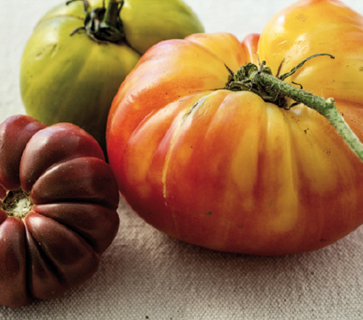TOMATOES
THE OBVIOUS AND IRONIC POINT of including tomatoes in this book is that the tomato is technically not a vegetable. But technicalities aside, in practice we treat tomatoes as one of our most important vegetables. I gravitate toward open-pollinated tomatoes (those not overly manipulated by industry). Varieties that predate 1940 are called heirlooms because they contain the most concentrated flavors, and appear in summer months in an astounding array of sizes, shapes, and colors. Their names speak volumes: Cherokee Purple, Black Prince, German Striped, Green Zebra, Great White; the list goes on for a country mile. Some more contemporary varieties, though not heirlooms, are equally delicious and have proven to be sturdy and steady crops for tomato growers: the cherry Sun Golds, Mortgage Lifters, Red Devils. The commercial tomato industry is plagued with abuse of all kinds, of the land, of the workers, and of the product.
One way to keep from drowning in the ugly politics of tomato growing is to demand access to high-quality tomatoes; to eat (and cook with) tomatoes that are in season, fully ripened, and grown close to home. A good tomato should not be considered an elitist food! Access to delicious, nutritious, and affordable vegetables should be part of our American birthright.
